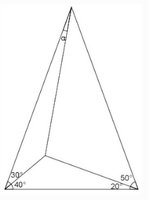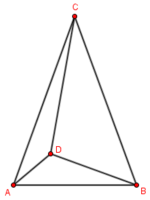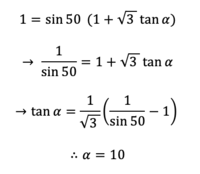I am working on this problem. Trying to find alpha ( lets call it 'x' instead) for this isosceles triangle.

I have been using the sine rule on the two middle triangles and managed to get to this point:
sin(30) sin (90+x) = sin50sin(150-x)
By 'guesswork and some graphical work' i have established the answer is x= 10. I am pretty sure that is correct.
However, I can't see how this is going to fall out easily.
I can do a little more, so the next line is
(0.5) cos x = sin50( 0.5 cosx+ (root3)/2 sinx)
But I can't seem to see a way around the sin50.
There might be a better way to solve the original problem that I am missing too, so any thoughts welcome!

I have been using the sine rule on the two middle triangles and managed to get to this point:
sin(30) sin (90+x) = sin50sin(150-x)
By 'guesswork and some graphical work' i have established the answer is x= 10. I am pretty sure that is correct.
However, I can't see how this is going to fall out easily.
I can do a little more, so the next line is
(0.5) cos x = sin50( 0.5 cosx+ (root3)/2 sinx)
But I can't seem to see a way around the sin50.
There might be a better way to solve the original problem that I am missing too, so any thoughts welcome!


